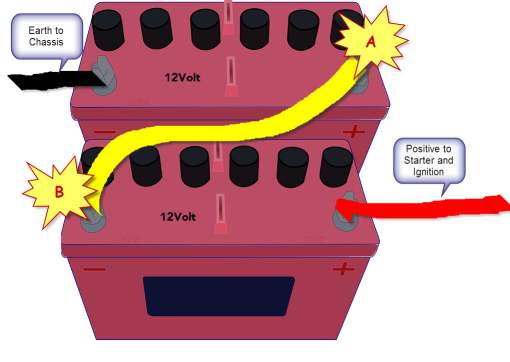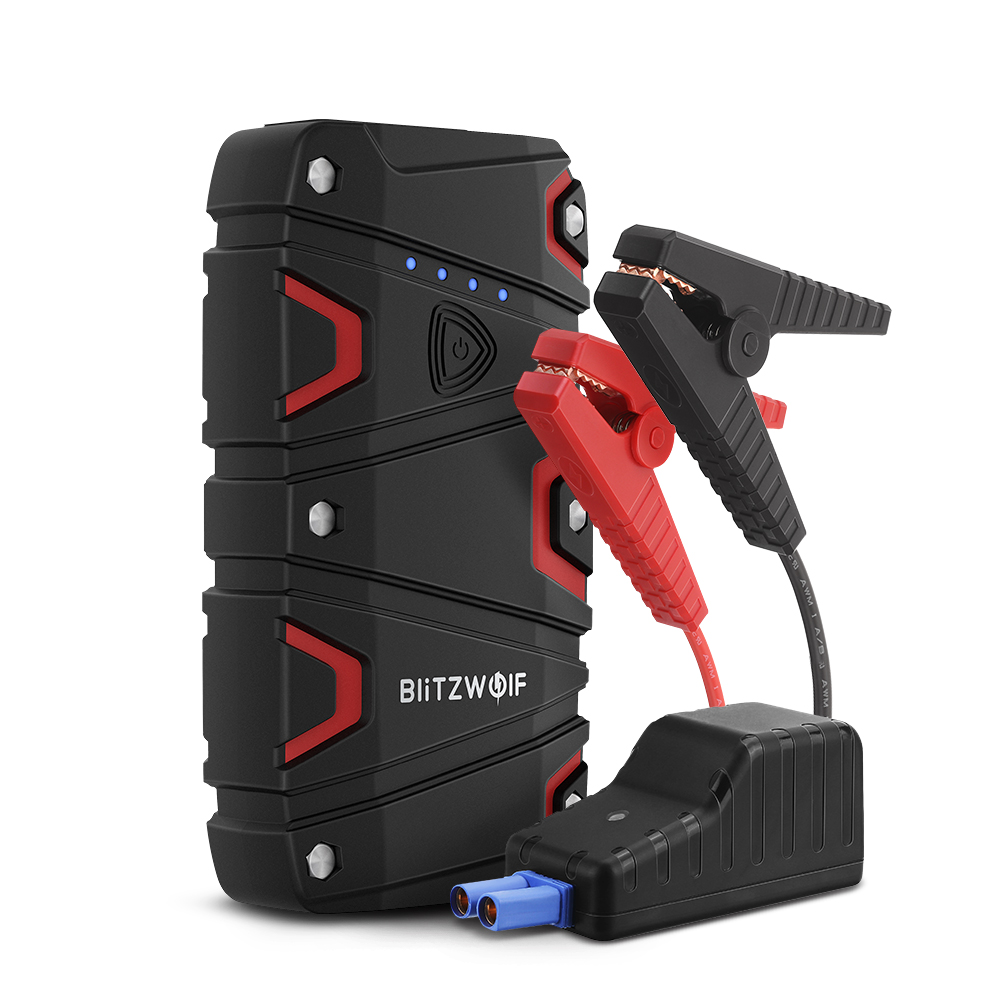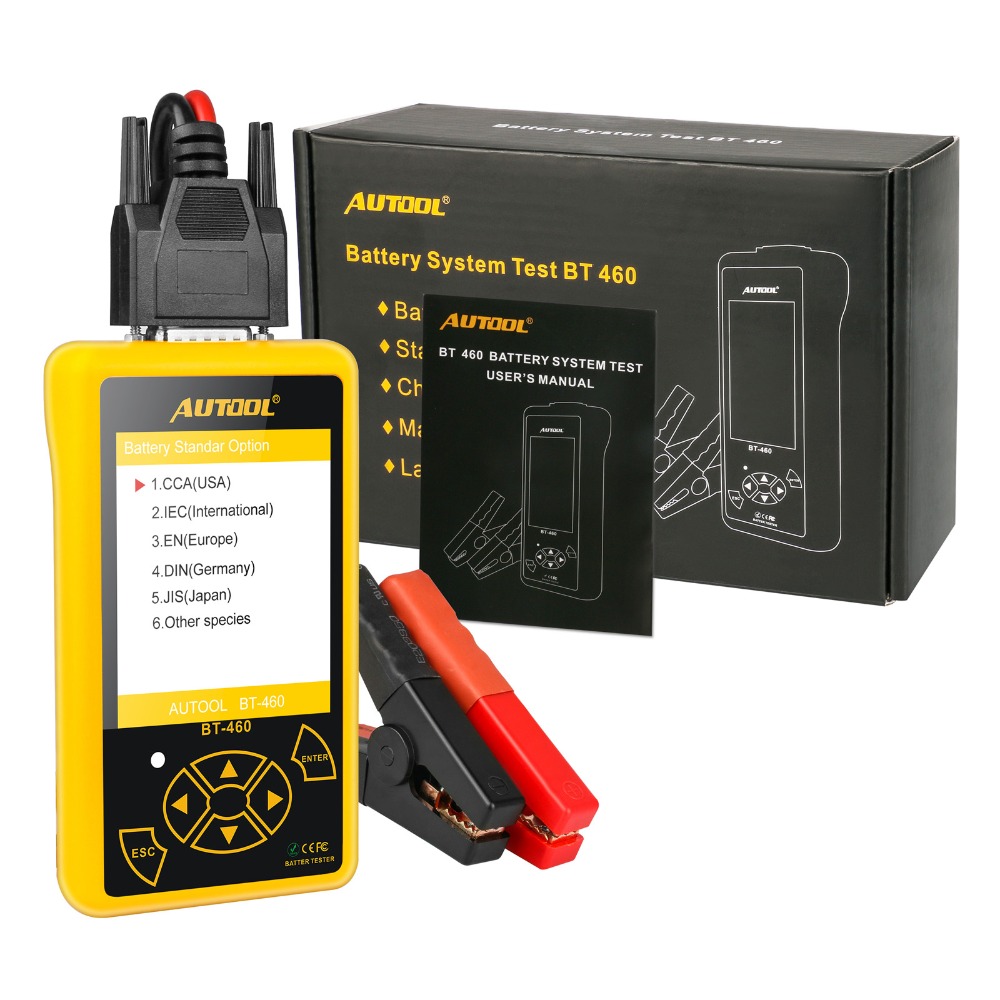Jump Start a 24 Volt truck from your 12 Volt car
Welcome to this post. Today we look at jump starting a 24 Volt system using a 12 Volt ordinary vehicle. There are a few things to keep in mind and a few mistakes that can cost you big time, so, read carefully and make double sure you have the connections correct!
Disclaimer: Everyone trying this method according to this post, do so at their own risk.
Which 24 Volt systems can be jumped from a 12 Volt system?
I will only speak about first hand experience in this post. As most know by now, I live in a motorhome (Bus). The motorhome has a 24 Volt starting battery configuration. It consists of 2 x 1000 CCA 12 Volt batteries connected in Series to give 24 Volts.
The battery system is connected as in this diagram which is the most common setup for 24 Volt systems in trucks and buses:

The Jumping Procedure
If this is the same way your 24 Volt system is connected, the starting procedure is quite simple.
Hook the + (positive/red) jumper cable to the Red (+) terminal of the 12V car battery and to the [Positive to Starter and Ignition] terminal on the 24 Volt system. (See diagram).
Make sure that it does not touch anything else. Now, hook the – (Negative/Earth/Black) jumper cable to the Earth terminal (-/Negative) of the 12V car battery.
Start the car.
Now, hook the – (Negative/Earth/Black) jumper cable to the – (negative) terminal marked “B” in the diagram.
Note: Double check that the jumper cables are hooked to the same battery of the 24V system!!
You may hear the revs on the car drop as the alternator starts to charge the truck/bus batteries.
What is happening in fact is that you are charging the one 12 Volt bus battery which in turn is sharing the charge with the other bus battery at 12 Volt. Thus it is perfectly safe. Run the car at higher revs for about one minute before attempting to start the bus/truck. Once the bus starts, quickly remove the jumper cables so that the bus alternator can take over the charging of the 24 Volt system.
The same result will be achieved by connecting the red jumper cable to the + / positive terminal marked “A” and the black jumper cable to the Earth terminal or Chassis of the bus.
Do you have a classic “JUMPSTART STORY”? Use the comments at the end of the post and tell us what happened!
A great gadget in these flat battery scenarios is this 12 volt battery jumper pack! I’ve had mine since 2014. It holds a charge for months and months.It is tucked away behind the seat in my van. I charge it approx once every 6 months, not that it needs it but I like to keep it full to the brim.

It can easily start 5 and more cars in a row before it needs recharging, it weighs very little and starts up to 2.5L diesels and v6 petrol engines. It does much more than just Jump Start your motorhome, it is a complete Power Bank that can charge your iPhone and anything else that uses a USB charger.
If you have a battery issue and need to replace it, check this post on which battery is best for your application. I also explain the latest Lead Crystal battery technology.
Did you find this information helpful? Please can you be so kind to leave us a comment as a courtesy for sharing it free?
Safe travels and hope to see you on the next post.
 iMars Portable Car Jump Starter 1000A 13800mAh Powerbank Emergency Battery Booster Waterproof with LED Flashlight USB Port
iMars Portable Car Jump Starter 1000A 13800mAh Powerbank Emergency Battery Booster Waterproof with LED Flashlight USB Port
 BlitzWolf® BW-JS1 Portable Car Jump Starter 12000mAh 800A Emergency Battery Booster Power Bank Waterproof with LED Flashlight QC3.0 USB Charging Port
BlitzWolf® BW-JS1 Portable Car Jump Starter 12000mAh 800A Emergency Battery Booster Power Bank Waterproof with LED Flashlight QC3.0 USB Charging Port
 AUTOOL BT460 12V 24V Battery Meaurement Analyzer Heavy Duty Power Tester Car Diagnostic Scanner
AUTOOL BT460 12V 24V Battery Meaurement Analyzer Heavy Duty Power Tester Car Diagnostic Scanner

Very informative clear instruction. Thank You NOAH
My pleasure. Thanks for the compliment.
Hi Noah, I own a 2007 Toyota Landcruiser Turbo Diesel with 24v system via 2x12v batteries.
I also have an SCA 12v SCA Compact Jump Starter Pack which says its suitable for 12v battery systems only.
I am wondering, after reading your Post on starting 24v systems with 12v cars or powerpacks, whether using the process you describe would work OK.
I would appreciate your comments.
Terry.
Hi Terry, I am sure it will work just fine. Try it with the headlamps switched on for the first time. If the engine is struggling to turn over, try with headlamps off. Technically, it is the same as having one fully charged battery and one flat battery. So, technically it is no different to a natural scenario. Keep in mind, I cannot guarantee anything. It is still done at your risk. Please let us know what you did if it works for you. Kind regards, Noah.
Hi,
Thanks for the thorough help.
My bus RV has 24v starting and 4x 185A 12v house batteries.
Do you know how I can connect the 12v house batteries to the 24v starting batteries?
I assume I’d need to keep them connected for a while before I try yo start the bus, since the 12v is deep cycle type?
Hi Marcus, apologies for this late reply. It is not a good idea to connect to your house batteries but in an emergency, I would have tried by disconnecting the solar and controller (if you have that) and then use the same method as I explained. You can also rewire the 4x12V batteries into 2x24V packs. Connect it in parallel to the starting batteries and it should get you going. Cheers.
Thanks Noah for excellent information and the diagram says it all! I have taken a screen shot of your post and it is now on file in my jump starter kit.
It is a great pleasure Tery, to know that my information served you well.
Kind regards
Noah
Good to see that I’m not the only one! I have been starting many of our fleet trucks with my portable jumper for the last few months here in New Zeland. Many of our trucks have been sitting over Covid lockdown, most of them actually needing a proper battery charge after getting them running.
I was curious to see if anyone else had done this and have been scrolling the web to find out. Thanks for the post!
Hi Sam, good on you. Thanks for your visit and every moment you spent on the great comment. This will give others confidence in our information, tips and tricks. Glad to be of service.
Kind regards
Noah
Hi Noah! Thanks for sharing your experience with us. I wouldn’t have come up with this and I’m glad I read your post. Now that I’m reading this suggestion, I know it’s completely safe if we hook the jumper cables to the correct terminals. It’s easy but I know we must be careful. A distraction can cost us big time.
Thanks for including the diagram.
Thanks for your comment Henry. Glad I could be of service to you. Have a great day and stay away from the virus!
Kind regards
Noah
That sounds great Thanks
Hi Alan, thanks for your comment. Did you actually do a jump-start? Let us know how it went.
Have a great 2020!
Regards
Noah